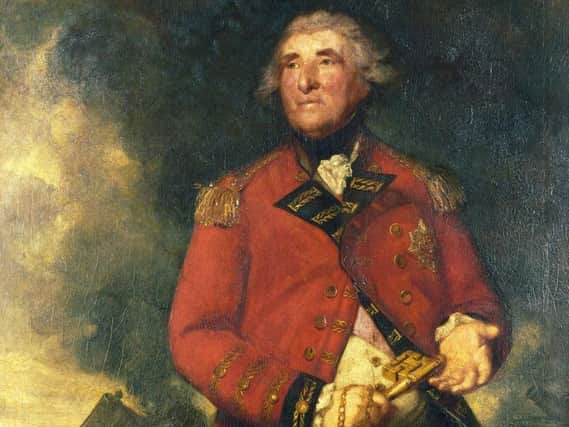Siege that earned Sussex peer's towering renown


It resulted for better or worse in the USA. But not many people will know that the British were actually the clear victors in what was that war’s biggest, longest and most desperate armed confrontation. Nor could many name where and when it occurred. Most would also be surprised to learn that not a single rebel American colonist fired a shot in anger during the entire fight.
I am speaking of the Great Siege of Gibraltar, the longest siege in British history that lasted from June 1779 to February 1783 and involved massive French and Spanish land and naval forces ranged against a vastly outnumbered British garrison leavened with some German auxiliaries.
Advertisement
Hide AdAdvertisement
Hide AdIt’s the stuff of which “Rule Britannia” is made. At times during the siege as few as 7,500 British soldiers were ranged against over 30,000 foes. Commanding our small army was the brilliant General George Augustus Eliott, a Scotsman by birth but a man who chose to make Sussex his home. Gibraltar Tower in Heathfield is a memorial to his soaring success in defending the Rock.
Eliott was born the 10th son of Sir Gilbert Eliott in 1717. He was sent abroad to be educated in the Netherlands and France where his studies engineering. He gained military experience with the Prussian Army and fought in the War of the Austrian Succession.
Eliott’s standing in military circles steadily rose. Back in England he served as Aide-de-Camp (ADC) to King George II. He was made a Colonel in time to fight in the Battle of Minden, one of a string of British and German victories over the French that led to 1759 being dubbed “Annus Mirabilis” – the “Miracle Year”. Eliott’s distinguished conduct was rewarded with the rank of Major-General.
In 1762 he accompanied a British force that captured Havana. It may well be that prize money from the Cuban campaign enabled him to purchase Bayley Park in East Sussex (it was renamed Heathfield Park after Eliott’s death).
Advertisement
Hide AdAdvertisement
Hide AdWhen he was 60 and could easily have retired to his country estate, Eliott accepted the role of Governor of Gibraltar in 1777. A year later saw him made a full General.
Fifteen months after France declared war on Britain in 1778, in overt support of revolutionary America, Spain, intent on recovering Gibraltar, (ceded in perpetuity to England under the terms of the Treaty of Utrecht of 1713), joined in. At this point as a personal aside, I must say I’ve always questioned Spain’s nerve in demanding Gibraltar’s return when Spain herself hangs on to her city enclaves of Melilla and Ceuta on the coast of North Africa.
France and Spain provided direct financial and military aid to the American rebels. But their priority was the capture of Gibraltar. The Rock’s location at the mouth of the Mediterranean was key to Britain’s control of that sea. The Franco-Spanish alliance sought a swift victory to be followed by an invasion of England.
On Gibraltar, Eliott’s engineering expertise brought great improvements to the Rock’s fortifications and extensions to the many tunnels and galleries hewn within the natural fortress. In July 1779, the siege began. Early attacks were easily repulsed. Quickly concluding that Eliott and his men occupied a well-nigh impregnable position, the enemy settled upon starving the garrison into submission.
Advertisement
Hide AdAdvertisement
Hide AdThough indeed, Gibraltar suffered greatly (scurvy becoming prevalent), crucially the Royal Navy delivered much-needed supplies in the nick of time on several occasions. Eliott coped well with the privations for he possessed a very modest appetite and remained an energetic man who could make do with just four hours sleep in a night.
In 1781 the British launched a surprise sortie out of Gibraltar, inflicting casualties, taking prisoners and seizing weapons and equipment from the enemy. Then in September 1782, the French and Spanish mounted a huge assault, involving as many as 50,000 troops, hundreds of cannons and 48 ships. Thousands of Spanish civilians lined the mainland hills expecting to witness the fall of Gibraltar. But the Rock’s 7,000 or so defenders held firm.
After this the siege stuttered to a close and was finally ended in February 1783. A month earlier, Britain had sent a message of thanks to Eliott and nominated him a Knight of the Bath. Lauded as a national hero, in 1787 he took the title Lord Heathfield. He died in 1790 at a health spa in Germany where he was also buried. Later his remains were brought home for reburial at Heathfield. Some years afterwards his family had the remains moved again – this time to St. Andrew’s Church, Buckland Monachorum, Devon, a location associated with his wife’s ancestor, Sir Francis Drake.
The 55 feet high Gibraltar Tower in Heathfield Park was built in 1792. It bears the inscription: “Calpe Defensori” meaning “To The Defender Of Gibraltar”. I believe the letters forming the words are fashioned from metal from the guns of Spanish seaborne batteries captured during the Great Siege. “Calpe” was the ancient name for Gibraltar, it being one of the Pillars of Hercules.
Advertisement
Hide AdAdvertisement
Hide AdA definitive new book, “Gibraltar: The Greatest Siege in British History” has just been published. Co-written by Roy Adkins and his Sussex-born wife, Leslie, it recounts in detail the stirring story of the conflict and Lord Heathfield’s key role in ensuring a momentous British victory. Published by Little, Brown (ISBN 9781408708675) it is available now in bookshops.